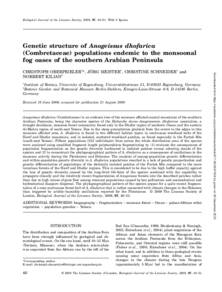Document
Genetic structure of anogeissus dhofarica (combretaceae) populations endemic to the monsoonal fog oases of the southern Arabian Peninsula.
Identifier
DOI: 10.1111/j.1095-8312.2008.01173.x
Contributors
Publisher
Linnean Society of London.
Gregorian
2009-05
Language
English
English abstract
Anogeissus dhofarica (Combretaceae) is an endemic tree of the monsoon affected coastal mountains of the southern Arabian Peninsula, being the character species of the Hybantho durae-Anogeissetum dhofaricae association, a drought deciduous, monsoon forest community found only in the Dhofar region of southern Oman and the eastern Al-Mahra region of south-east Yemen. Due to the steep precipitation gradient from the centre to the edges in this monsoon affected area, A. dhofarica is found in two different habitat types: in continuous woodland belts of the Hawf and Dhofar mountains, and in isolated, scattered woodland patches, as found especially in the Fartak Mts (south-east Yemen). Fifteen populations (212 individuals) from across the whole distribution area of the species were analysed using amplified fragment length polymorphism fingerprinting to: (1) evaluate the consequences of population fragmentation on the genetic diversity harboured in isolated patches versus cohering stands of the species and (2) to reconstruct the phylogeographical pattern of A. dhofarica as a consequence of oscillations in the monsoon activity during the Pleistocene and Holocene. The analysis of among-population genetic differentiation and within-population genetic diversity in A. dhofarica populations resulted in a lack of genetic pauperization and genetic differentiation of populations of the distinctly isolated patches of the Fartak Mts compared to the more luxurious forests of the Hawf and Dhofar regions. This is considered to be due to the high buffer capacity against the loss of genetic diversity caused by the long-lived life-form of the species combined with the capability to propagate clonally and the relatively recent fragmentation of Anogeissus forests into the described patches rather than due to high values of gene flow among remnant populations caused by bee pollination and anemochorical and hydrochorical diaspore dispersal. The phylogeographical pattern of the species argues for a quite recent fragmentation of a once continuous forest belt of A. dhofarica that is rather connected with climate changes in the Holocene than triggered by aridity-humidity oscillations reported for the Pleistocene.
Member of
ISSN
0024-4066
Resource URL
Category
Journal articles

